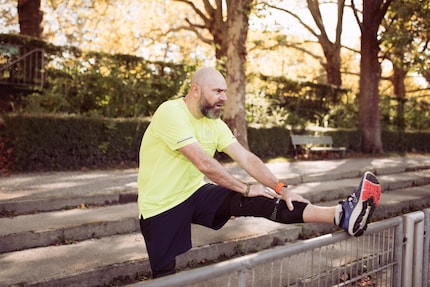
Guide
My heart rate, your heart rate
by Patrick Bardelli

Running injuries usually aren’t just a case of bad luck and can often be avoided. Lack of rest time, being overly ambitious or doing the same training every time can all play a part. Below are 10 of the most common training mistakes – I’ve been there, done that and got the T-shirt for all of them.
You’re in good shape. You’ve been working towards a big goal for a while now and all of a sudden you feel something in your calf. That’s it. You’re done. You have to call off the competition. Rather than running your first marathon, you’re stood there, empty handed and disappointed, with an injured calf to boot. For runners who start training months in advance for a big goal like this, it’s unfortunately a common story. But in most cases, it’s one we can in fact avoid if we know how...
You’ve only got two more months until the event you’ve been training for. You feel good and increase your running intervals from three to five. Even though your mind and cardiovascular system step up to take on the extra work, there’s still the risk your ligaments and tendons won’t cope. And you could get injuries from overstraining. Then the Achilles tendon gets inflamed and the sole of your foot hurts or the pain goes up into your calf muscle.
Solution: increase the number of intervals or reps slowly. And make sure you lower the intervals again before the competition. You also want to keep the training intervals short at the beginning and initially finish them with lower intensity. Then keep incorporating a week where you don’t run as much as normal so your body can rest and recover.
This is the classic mistake you’ll see jogging enthusiasts make. They always run for the same length of time and at the same pace. And then they wonder why they never get any faster.
Solution: vary how long you run as well as the intensity of your run. The basic principle is that 75% of your training intervals should be at your normal pace and last between 45 to 90 minutes. Only about 25% of your reps should be high intensity. This makes the duration of exertion of each training session between ten and 30 minutes at high intensity and 30 to 90 minutes in the middle range. You can include long jogs here and there for up to two hours or as long as three hours if you’re training for a marathon. Find out more about high-intensity running and heart rate here:
This is another classic example. A lot of people have a guilty conscience in the last few weeks before a competition because they think they ought to have trained more. But trying to crowbar in what you’ve supposedly missed is not a good idea.
Solution: stick to the plan. Trust the plan you developed at the start of training and follow this as best you can. If you run each training session according to set intervals then you’ll know you can reach your target time in the competition. All you need in the days before the competition is «movement therapy». No one has ever stood at the start line and thought they were too well rested – too tired, though, yes.
Unlike professional sportspeople, running enthusiasts usually don’t have as much time to dedicate to recuperation. But there’s all the more need for rest after fast intervals so that your body can implement the new speeds.
Solution: don’t just plan your training routine. Also plan your rest and recovery and work it into your daily routine. For instance, you might treat yourself to a regular massage or a trip to the sauna. Or perhaps you decide to lie down for a few minutes after a training session before you get back to it. Training AND rest go together just as ebb can’t be separated from flow.
Wearing worn out or unsuitable shoes for running means you won’t be having as much fun. And you also risk problems with your musculoskeletal system.
Solution: the running shoes you wear have to be adapted to your running style and your feet. Ideally you’ll have two or three pairs so you’re not always wearing the same one. This ensures that the muscles are challenged from many sides and angles.
This is when you clock up the kilometres but you don’t have any time left for complimentary activities.
Solution: running is a complex thing. It combines a mix of factors, such as endurance, power, agility, coordination and speed. Combining an athletics programme with gymnastics exercises (for best results at least twice a week) ensures you stay complaint-free, more able to tolerate each training session, and flexible both physically and mentally in day-to-day life.

Pain is temporary; glory lasts forever. Catchphrases lure a lot of sportspeople like a moth to a flame. But these catchphrases don’t give as much value as you’d think. Of all endurance sportspeople, runners are the most susceptible to injuries.
Solution: listen to your body, take it seriously and act on what it says early enough. You need to give it a break when it needs it. In fact, the body normally rewards rest periods with increased performance. And by the way, your heart can’t see what you’re doing. So you can train it by cycling or swimming now and again and protect your musculoskeletal system.
Long runs, also known as long jogs, are indeed like life insurance on your way to a successful long-distance run or marathon. But equally, you do have to take a cautious approach to long runs.
Solution: increase your longest interval to date to a maximum of 15 minutes per week and intentionally keep the intensity very low. Only once you can easily run two to three hours should you try to up the intensity, for example at 90% of your marathon speed or a continuous increase in speed (crescendo). As a general rule, you shouldn’t run for longer than three hours even if the marathon itself will take you a lot longer. The benefits of longer running intervals is not in proportion to the risk of getting injured – especially for people who just run in their spare time.
Are you tempted by the four-hour mark in a marathon or the 90-minute mark in a half marathon? If that’s you, it might be an idea to give your performance an honest assessment and not fool yourself.
Solution: run at your performance level and not at the performance you’d need for your dream time. That way you know you’ll continue to improve. And your dream time will eventually become reality.
So you like to run competitively but you don’t really have any time to dedicate to it?
Solution: bring some structure to your training sessions. Set yourself two big goals each year and prepare for these with three to a maximum of four competitions. After each event, give yourself a week to recover and only start running intensively again once you’ve worked your way up to running two kilometres in a day.

Read more about running here:
Find background pieces, news and trends and lots of other information in my author profile. Click on «Follow author» so you don’t miss out on any updates.
From radio journalist to product tester and storyteller, jogger to gravel bike novice and fitness enthusiast with barbells and dumbbells. I'm excited to see where the journey'll take me next.
Practical solutions for everyday problems with technology, household hacks and much more.
Show all